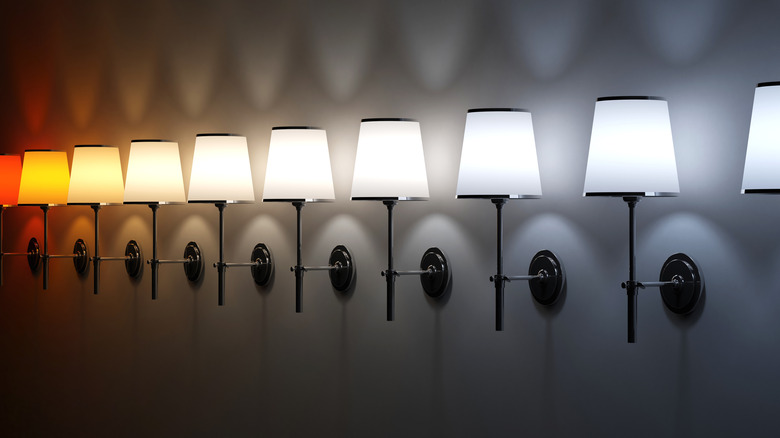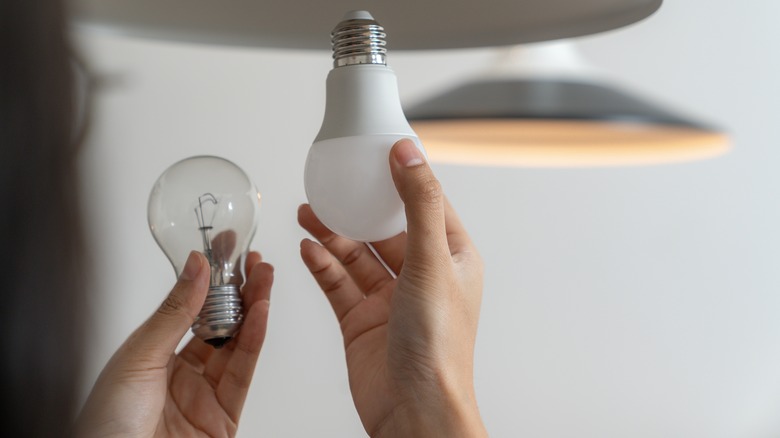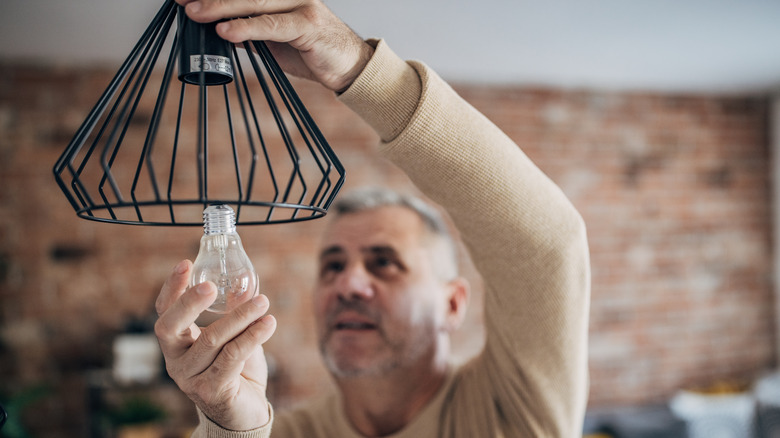Blue, Yellow, Or White? How To Choose The Right Light Bulb Colors For Your Home
The lighting used in your home completely sets the mood and alters how your finishes and color palette appears. As an interior designer, I'd happily argue that using the correct lighting color temperature is essential for making sure a space looks and feels as intended. But there is an entire aisle full of light bulb options, ranging from yellow to white to blue, so how do you know which color is best for your space?
In order to pick the perfect bulbs for your home, you need to first understand the color temperature scale on which they are measured. The level of warmth a bulb produces (or how warm or cool it appears to the human eye) is measured on a scale called Kelvin (K) that ranges from 1,000 to 10,000. Light bulbs on the market will range from about 2000K to 6500K, which will appear yellow to white to blue as you move higher on the scale. Candlelight is equivalent to about 2000K and will have a very warm, yellow tone. Conversely, daylight is around 5500K to 6500K and produces a cool blue light, available on the market as daylight or sunlight bulbs. Right in the middle, a 2700K or 3000K tone will be a warm or soft white, while 4000K moves more into a cool white, both noted as such on their packaging.
So, what do all of these color temperatures mean in terms of creating a lighting scheme in your home? Follow my guidelines below to select the perfect bulb for every room and task, as well as avoid lighting that feels too harsh or sterile. In the quest to create an inviting, cozy, well-lit home, color temperature is everything — so choose your bulbs wisely!
Which color temperature bulb is right for your home?
When choosing which bulb color is best for your home, there are general standards that professionals live by to make the choice easy. For living rooms, bedrooms, and any space meant to promote relaxation, connection, and coziness, my personal go-to is a warm white 2700K bulb for both decorative lamps and overhead fixtures. Some people will go as high as 3000K for these spaces (still warm white, but less so), but many find that level of light too stimulating or bright for the evenings, even when controlled on a dimmer. Your circadian rhythm is affected by light, with warm colors signaling the wind down to sleep, making the warm white 2700K bulbs ideal for creating an inviting, calming atmosphere in your living and sleeping spaces.
For task and overhead lighting in areas where you need to be able to see in greater detail, such as in the kitchen, bathroom, or home office, a less yellow warm white 3000K bulb is perfect for clarity and alertness without being too harsh. Again, some people go a little higher, around 3500K, for bathroom vanity lights or kitchen pendant lights, but this can be severe on the eye, especially while cooking dinner or during your evening bathroom routine. Anything over 3000K can start to look too clinical, sterile, and downright unflattering for a residence, as the goal is to create a happy, welcoming, warm home rather than a cold commercial space.
Now, as for my advice? Anything over 3500K has absolutely no place in an interior residential setting unless it is in a workshop or garage that needs extreme detail lighting like a hospital. Bulbs labeled daylight that are over 5000K should be passed by without a second glance, unless they are grow lights for vegetables and herbs.
Exceptions and considerations for choosing the right color temperature
These guidelines will help you choose the right bulbs the vast majority of the time, but there are a few instances where you may want to break the rules. For example, sometimes I use a 2700K bulb in a powder room, as it is only for guests (not applying makeup every day) and the flattering warm light makes everyone look lovely. Conversely, while I always use 2700K bulbs in bedrooms, I opt for a brighter 3000K for walk-in closets, as you want to be able to see your clothing in a truer white light while still having the space feel flattering.
Don't be afraid to swap 2700K and 3000K bulbs when it's appropriate for your needs, but you should generally never mix different color temperatures in the same room. Once again, there are exceptions — such as a warmer mini lamp on a kitchen counter, that functions as a night light when the overhead lights are off — but typically, mixing color temperatures in the same space looks incorrect.
Finally, dimmers are your best friend! Some people confuse wattage or light output with color temperature and think they need a cooler white bulb to make the room bright. However, having a higher wattage warm white bulb (2700-3000K) on a dimmer will help you control the overall brightness without changing the color or harshness of the light. Similarly, fully controllable smart bulbs allow you to set the ideal color temperature and brightness levels, even scheduling them to automatically change throughout the day to create your perfect lighting atmosphere at all times. The next time you are standing in the light bulb aisle at the store, use these guidelines to make the color choice a no-brainer.


